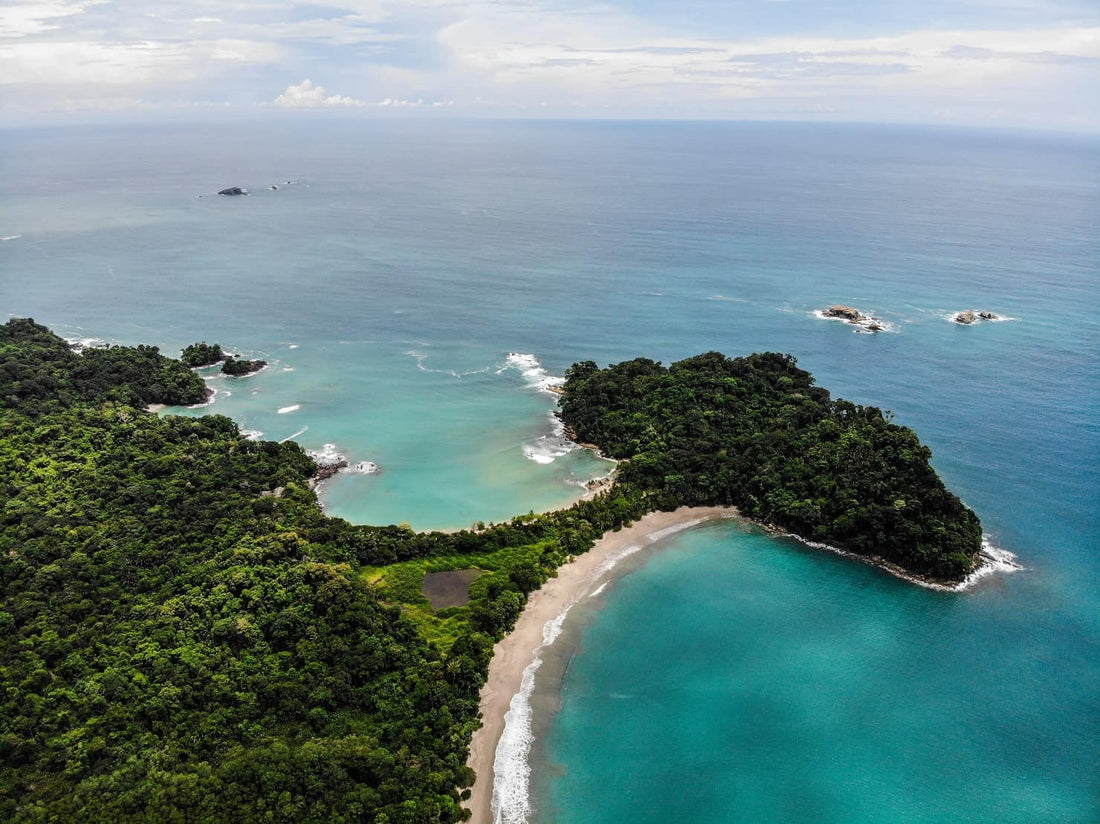
Quepos, Costa Rica: A Coastal Town with Strong Coffee Ties
Share
Quepos sits on Costa Rica's central Pacific coast in Puntarenas province. This small harbor town draws people for its sport fishing and access to Manuel Antonio National Park. You find beaches, rainforests, and a mix of local spots for food and drinks.
For coffee fans, Quepos offers roasters and cafes that use beans from across the country. Local businesses roast and serve fresh coffee, and some tours show how it's grown and processed. The town blends coastal life with Costa Rica's coffee tradition, making it a spot to relax with a cup while exploring nature.
The History of Quepos
Quepos takes its name from the Quepoa people, an indigenous group related to the Boruca and Huetar ethnic groups. They lived in the area during the 1500s, building homes from cane and thatch. Spanish explorers first spotted the coast in 1519 under Hernán Ponce de León. By 1563, conquistadors led by Juan Vázquez de Coronado settled the region and named it San Bernardino de Quepo.
Over time, the Quepoa population declined, and by the late 1800s, they had largely disappeared. Banana plantations shaped the town in the early 1900s, bringing workers and building a railroad. When bananas faced disease, the focus shifted to African palm oil.
Tourism grew in the 1970s with the creation of Manuel Antonio National Park nearby. Today, Quepos thrives on visitors who come for fishing charters and park hikes. The town's past as a banana port shows in its layout, with streets once used for shipping fruit now lined with shops and eateries.
This background explains why Quepos feels like a working town with a tourist edge. People here maintain ties to the land, much like coffee growers in other parts of Costa Rica who farm on family plots.
Attractions and Activities in Quepos
Quepos centers around its marina, Pez Vela, where boats launch for deep-sea fishing. Anglers catch marlin, sailfish, and tuna in these waters, known as some of the best for sport fishing worldwide. The marina also hosts shops and restaurants, making it a hub for daily life.
Just south, Manuel Antonio National Park covers rainforests and beaches. Trails lead to spots where monkeys, sloths, and birds appear often. The park's beaches, like Playa Manuel Antonio, offer white sand and clear water for swimming. Hikes range from easy paths to steeper ones with ocean views.
In town, the six-block center has art galleries, gift shops, and bars. Farmers' markets on weekends sell fresh produce, including fruits that pair well with local coffee. For adventure, try zip-lining or ATV tours in the surrounding hills. Rafting on nearby rivers adds excitement during the rainy season.
Quepos stays active year-round, with dry months from December to April best for outdoor plans. Rainy periods bring fewer crowds and greener landscapes. Many visitors rent cars or use shuttles to move between the town and park.
The Coffee Scene in Quepos
Costa Rica grows Arabica coffee on high-altitude farms, producing beans with bright flavors and clean finishes. While major coffee regions lie north near San José, Quepos hosts roasters who bring those beans to the coast. Local spots roast small batches, focusing on single-origin types from estates like those in Tarrazú or Naranjo.
Roasters in Quepos mill and roast beans fresh, often selling them in shops or serving them in cafes. This setup lets you taste coffee straight from the source without traveling far. Many places combine coffee with chocolate or vanilla, reflecting Costa Rica's crop diversity.
The scene suits casual drinkers and those who want to learn more. Cafes open early for breakfast brews and stay late for afternoon picks. Prices stay reasonable, with a cup costing around 1,500 to 2,500 colones. Baristas often explain bean origins, helping you pick based on taste preferences like nutty or fruity notes.
Quepos' coffee spots fit the town's laid-back feel. You can grab a pour-over before a fishing trip or sip an iced version after a park visit. This connection highlights how coffee remains part of daily life here, even away from the main growing areas.
Top Coffee Shops and Roasters in Quepos
Several spots in Quepos stand out for their coffee. Café Milagro, started in 1994, roasts premium beans in small batches. They source from estates across Costa Rica, offering types like light roasts with citrus hints or darker ones with chocolate tones. Their shop in downtown Quepos sells bags to take home.
El Patio de Café Milagro in nearby Manuel Antonio serves breakfast with fresh brews from 6:30 a.m. They make smoothies and iced coffees for lunch, using the same roasted beans. Dinner options include craft beers alongside coffee desserts.
Bonding Coffee Roaster, in Barrio Los Ángeles, uses premium beans in a garden setting. They brew hot and cold drinks that honor Costa Rica's traditions. The spot pairs coffee with meals made from local ingredients.
Emilio's Cafe offers Mediterranean touches with its coffee menu. You get strong espressos or lattes made from Costa Rican beans. Soda Sánchez provides simple, affordable cups in a local eatery style.
Here's a table of popular coffee places in Quepos:
| Name | Location | Highlights |
|---|---|---|
| Café Milagro Roaster | Downtown Quepos | Fresh roasts, single-origin beans |
| El Patio de Café Milagro | Manuel Antonio | All-day service, iced options |
| Bonding Coffee Roaster | Barrio Los Ángeles | Garden atmosphere, premium brews |
| Emilio's Cafe | Manuel Antonio | Espresso drinks, food pairings |
| Soda Sánchez | Quepos town center | Affordable, local vibe |
These options cover different tastes, from quick stops to sit-down experiences.
Coffee Tours Near Quepos
Tours near Quepos combine coffee with chocolate and vanilla for a full look at local crops. One popular option starts at nurseries where guides explain planting needs like altitude and soil. You see beans grow, then learn harvesting and processing steps.
The Esquipulas Rainforest tour shows coffee from seed to cup. Visitors walk through plots and taste fresh brews. Other tours add sugar cane milling, where you press stalks for juice.
A common combo covers chocolate making, vanilla pollination, and coffee roasting. These last about three to five hours, often including transport from Quepos. Guides share facts on sustainable farming, like shade-grown methods that protect wildlife.
Costs range from 15,000 to 25,000 colones per person, with some including meals. Book ahead during peak times. These experiences work well for families or groups, as they mix education with hands-on parts like grinding beans.
While Quepos lacks large plantations, these tours bring the process close. They show why Costa Rican coffee ranks high globally, with its focus on quality over quantity.
Where to Stay and Dine in Quepos
Quepos has lodging for various budgets. Budget hotels in town offer rooms around 20,000 colones per night. Mid-range spots near the marina add pools and views for 40,000 to 60,000 colones. Luxury options in Manuel Antonio provide beach access and spas.
Dining mixes seafood from the harbor with Costa Rican staples like rice and beans. Many places use fresh catches in ceviches or grilled fish. For coffee lovers, cafes double as eateries with sandwiches or salads.
Try a casado plate with coffee at a soda for a local meal. Restaurants at marinas serve international dishes with Costa Rican twists. Nightlife includes bars with live music, where you can end the day with a coffee cocktail.
Markets supply fruits and snacks for picnics. Overall, eating out stays affordable, with meals under 5,000 colones at casual spots.
Practical Tips for Visiting Quepos
Fly into San José, then drive or take a bus three hours to Quepos. Domestic flights land nearby for quicker trips. Rent a car for flexibility, but shuttles cover most needs.
Pack light clothes, rain gear, and bug spray. Use sunscreen for beach days. ATMs handle cards, but carry cash for small vendors.
Respect nature by sticking to trails in the park. Avoid feeding animals to keep them wild. Learn basic Spanish phrases for better interactions.
Visit during dry season for sun, or wet season for deals. Check park entry fees, around 8,000 colones. For coffee buys, ask about roast dates to get the freshest bags.
Quepos offers a straightforward way to see Costa Rica's coast and taste its coffee. Plan a few days to cover the basics, or longer for deeper exploration.
